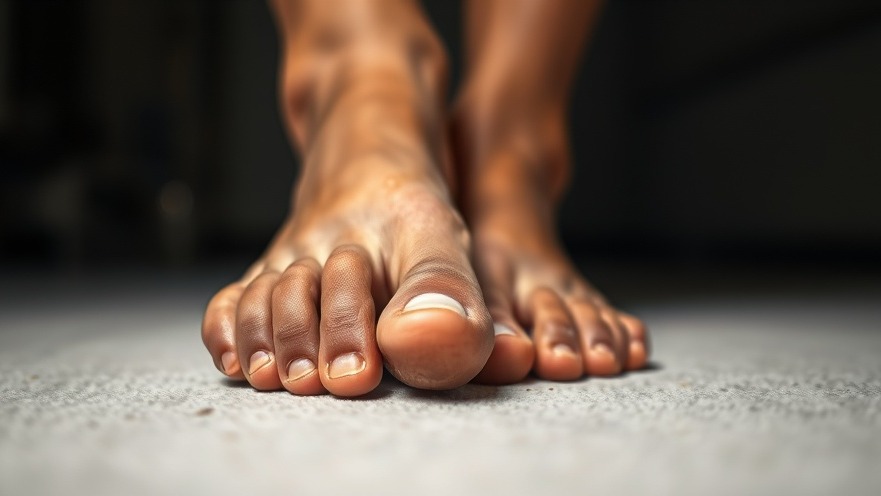
Understanding Athlete’s Foot: What You Need to Know
Athlete’s foot, known medically as tinea pedis, is more than just an annoying itch; it's a widespread fungal infection that affects the skin on the feet. Caused by dermatophytes, a group of fungi that thrive in moist, warm environments, this condition often leads to symptoms such as persistent itching, red or peeling skin, and even painful blisters in severe cases. Awareness of this condition is crucial, especially for gym-goers who frequently encounter ideal breeding grounds for such fungi.
Why Gyms Are a Hotspot for Fungal Infections
Why is athlete’s foot so contagious, especially in gym settings? The answer lies in communal spaces. Gyms are often warm and damp—perfect conditions for fungal growth. Shared areas like locker rooms, showers, and saunas can harbor the fungus, where it can easily be transmitted through direct contact or touching contaminated surfaces. During peak usage times, such as January, when many people are starting New Year's fitness resolutions, the risk of encountering this infection spikes significantly.
Essential Tips to Prevent Athlete’s Foot
Staying proactive is the best way to combat athlete’s foot. Here are key strategies that can help you keep your feet fungus-free while enjoying your workout:
Always Wear Shoes: Avoid walking barefoot in communal areas. Flip-flops or water shoes act as a protective layer against potential infections.
Dry Your Feet Thoroughly: Ensure that your feet are dry after showering, especially between the toes, to minimize moisture.
Utilize Antifungal Powders: Consider using antifungal powder or spray on your feet and within your shoes to keep them dry and free from fungus.
Change Socks Regularly: Wear moisture-wicking socks and change them immediately after your workout to prevent damp feet.
Keep Gym Shoes Dry: Allow your gym shoes to dry out completely between uses. Alternating between pairs helps prevent moisture buildup.
Avoid Sharing Personal Items: Never share towels, socks, or shoes. Fungus can easily transfer from one person to another through these personal items.
Spreading Beyond the Feet: What to Watch For
If athlete's foot does strike, it can spread beyond the feet if proper hygiene isn't maintained. Touching your feet and then other body parts without washing your hands can lead to infection affecting areas like the hands or groin. Always dry your body off first and your feet last using a clean towel to prevent cross-contamination.
Signs of Athlete’s Foot: Identifying the Infection Early
Recognizing athlete's foot in its early stages allows for swift action. Here are the common signs:
Red, Scaly Skin: Redness and dryness between the toes signify an infection.
Itching and Burning: Affected areas may feel overly itchy, especially when warming up or sweating.
Skin Cracking and Peeling: Frequently, infected skin may crack and flake.
Formation of Blisters: Fluid-filled blisters can develop on the feet, leading to further discomfort.
Understanding Common Misconceptions About Athlete’s Foot
It’s important to debunk some myths surrounding athlete’s foot. For instance, many believe that only athletes or highly active individuals are susceptible to this condition. In reality, anyone can contract this infection, as the environment in which it flourishes is easily accessible to all. Also, some think that treatment is unnecessary; however, ignoring treatment can lead to escalating discomfort and potential spreading to other body areas.
Proactive Lifestyle Choices for Healthy Feet
Incorporating healthy habits into your routine can also help maintain foot health. Regularly check your feet for any changes, wear breathable footwear, and ensure hygiene after engaging in physical activity. Making these lifestyle choices reflects awareness of overall well-being and foot health.
Step into Wellness: Keep Your Feet Fungus-Free!
Understanding and mitigating the risk factors associated with athlete’s foot is essential for anyone visiting a gym. As you make strides toward your fitness goals, keep your feet protected by following the outlined preventive measures. Remember, healthy feet lead to a healthy and active lifestyle. Don’t hesitate to consult with a medical professional should symptoms arise, and embark on your wellness journey with confidence!
 Add Row
Add Row  Add
Add 




Write A Comment